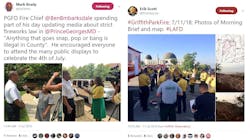Fire PIOs Taking Advantage of Social Media
The growing pains of embracing change and new technologies are felt in all walks of life and in all industries, particularly those steeped in such long-standing traditions as those of the fire service.
Firefighters become accustomed to the tools and techniques that work best and tend to stick with them, and that can easily be said of the emergence in the last decade of social media platforms.
After initial resistance from leadership for a host of reasons—many of them grounded in legitimate concerns such as privacy and HIPAA law—many public information officers at various fire departments both big and small are finding that social media can be a vital tool for getting information out to the media, alerting the public to incidents that may affect them, recruiting new personnel and promoting community risk reduction campaigns.
Embracing social media
"I used to go around and teach a few years back and ask who was on social media, and you'd only get a few people raising their hands," said Mark Brady, pubic information officer (PIO) for the Fire & EMS Department in Prince George's County, MD, and a PIO course instructor. "Not many people were engaging. Now I go into a classroom and ask who's on social media and just about everybody in the room raises their hand."
"I think leadership has really bought into these programs."
Brady frequently captures photo and video from fire scenes like the one below which he posted to his Twitter feed, which has around 18,400 followers. He says it not only shows the hard work of his department's personnel, but it also helps the public understand what it is these men and women do on a daily basis.
The days are basically gone when a fire department PIO was stuck in an office answering media calls after an incident. With the advent of mobile technology and applications like Twitter, Facebook and Instagram, PIOs are out at active scenes offering live updates and giving their departments a robust social media presence.
The public is often finding that media outlets have a story posted to their websites with a good dose of detailed information and striking photos before a structure fire is even extinguished. All of that is thanks to social media messaging.
"Years ago I used to have a notepad and kept a roll of quarters in my pocket," said Las Vegas Fire & Rescue PIO Tim Szymanski, who also teaches PIO courses and has written on the topic of social media for Firehouse. "I'd find the nearest pay phone to get the information out. Everything is so much simpler now."
"I do almost everything on my cell phone."
Below is an incredible photo of a fully involved residential fire posted by Szymanski several months ago to the Las Vegas Fire & Rescue Instagram feed, which has over 10,000 followers:
A Twitter, Instagram or Facebook user can easily find fresh photos or video from incidents posted by fire departments around the country on an almost hourly basis, and policies and guidelines are being put in place to maintain strict adherence to things like HIPAA laws.
Not just incident coverage
As fire departments and their personnel begin to fully grasp how much potential there is to engage with their communities through social media, successes in community risk reduction are starting to be felt in a big way.
Brady pointed to a recent push through social media to alert the public about a change in smoke detector guidelines, and the response was so massive that the department had to strike a deal with an outside group to meet the demand for installations when they ran out of detectors.
"We were overwhelmed by just how many requests we received," Brady said.
Releasing crucial information on incidents to the media and the public as well as community risk reduction initiatives on the same feed is pretty much the norm around the country with a lot of departments, but the Los Angeles Fire Department (LAFD) has taken things a step further with two Twitter feeds.
The @LAFD feed (125,000 followers) is used for details related to fire incidents, while @LAFDtalk (40,000 followers) is used for queries from the public and for messaging related to fire and prevention awareness. This approach can be beneficial to such a large fire department, but it does come with its own concerns.
"A very important thing is consistency of message across platforms," said Capt. Erik Scott, who serves as PIO for the LAFD and also has his own Twitter feed with over 3,300 followers.
Scott's feed is very active, and you can find frequent posts covering incidents such as the Griffith Park brush fire that broke out Tuesday and forced the closure of the famed Griffith Observatory:
Scott says the idea of having two dedicated feeds for the department to communicate with the media and the public was brought up very early on when the LAFD realized the benefits of social media engagement, although such an approach may not be right for smaller departments.
One of the LAFD's rank and file members—firefighter Brian Humphrey—was instrumental in helping the department launch its various forays into social media messaging. Humphrey lists off the benefits social media can have for a fire department in the video below, calling it a "force multiplier."
The San Francisco Fire Department, meanwhile, is relatively new to the social media landscape having named a dedicated PIO and launching its Twitter account only two and a half years ago. Still, the department has a Twitter following of about 14,000.
Lt. Jonathan Baxter serves as PIO in San Francisco, and some of the initiatives his department is touting as it increases its social media presence are efforts to engage with the public across language barriers in order to include community members whose primary language is not English.
Baxter says he also tries to understand that a PIO posting photos and video from a fire scene may have an adverse effect on media members whose livelihood depends on the photos and videos they capture.
"We maintain friendly partnerships with local media groups so they can continue to do their jobs," said Baxter, who added that sometimes holding back on releasing multimedia content from a scene can serve as a level of protection if the media's narrative doesn't tell the whole story from an incident.
Baxter also sees a huge benefit in live updates through social media like the one below from his Twitter feed because it handles two vital tasks.
"Not only does it help the public know the details of an incident, but it also lets the families of those firefighters know what's happening," Baxter said.
Recruitment tool
It's common knowledge that social media was at first embraced by a younger generation, and as departments move into the future they understand that the best method they have to bring in new personnel is through recruitment on social media.
Brady recently sent a post to both Twitter and Facebook and the initial response was very strong:
"We've seen that through all of the mediums we use, particularly Facebook," Brady said. "We just announced a job this week, and just the number of shares where someone tagged a person's name who might be interested in the job, it was very high. We know it's reaching a lot of people."
With one of the biggest concerns in the fire service of late being the tightening of budgets, Brady has a simple message for departments looking to recruit.
"If you're part of a smaller department and you're out to recruit, this is an excellent means to do that—and it's extremely inexpensive. It's basically free. I mean, you can't get much better than that."
Tips for posting
Although this burgeoning form of engagement with the public continues to evolve in interesting and surprising ways, here are some best practices and methods to consider when increasing your fire department's social media profile:
- Trial and error may be necessary to discover what works best for your department and community, but always be cautious about the information you release.
- Maintain an objective tone and steer clear of personal opinions in all social media messaging to keep in line with your department's mission.
- Don't limit your engagement to one platform since varying age groups use different platforms. An older demographic can be reached through Facebook, while younger people spend more time on Twitter and Instagram.
- Consider that your social media followers are not just citizens but also the family and friends of your personnel who may be seeking updates on incidents to know their loved ones are safe.
- Explore composing posts that are frequently sent on specific dates such as the first of the month to remind citizens of prevention measures such as checking their smoke detectors.
- Always check with a department PIO if one is on staff to clear any photos or video you shoot at an active scene before releasing those items through social media.
- Listen to the feedback you receive from your followers to better craft your messaging and appeal to the community's public safety needs.
About the Author

John Kosik
John was the managing editor of Firehouse after joining the Firehouse team in April 2017 after spending most of his career in journalism writing and editing sports and music content for the Associated Press in New York City. Transitioning into coverage of the fire service industry was a move close to his heart with several friends and family members serving in the FDNY. He lives in Chicago.
